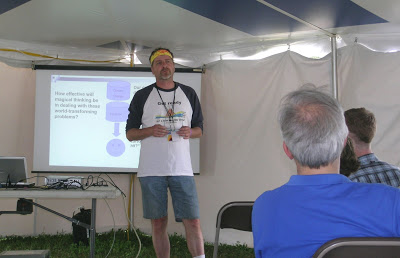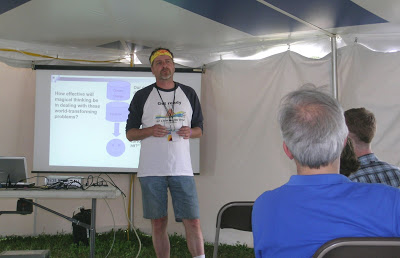
by jboullion | Jun 24, 2009 | Uncategorized

From a presentation by RENEW’s Michael Vickerman (above) at the Energy Fair of the Midwest Renewable Energy Association:
Energy Policy Must Recognize Energy Realities
+ Supplies of liquid fuels peaked in 2008
+ Capital is disappearing before our very eyes
+ Energy and food are the original currencies
+ The shift from stores to flows is inevitable
+ Current economy is highly energy-intensive
+ Energy return on energy invested (EROEI) must inform decision-making
+ We can’t afford to prop up existing energy sinks or engage in wealth-draining military adventures
Three paths to choose
+ Business as usual
+ Clean green technology
+ Curtailment and community

by jboullion | Jun 24, 2009 | Uncategorized

From a presentation by RENEW’s Michael Vickerman at the Energy Fair of the Midwest Renewable Energy Association:
Energy Policy Must Recognize Energy Realities
+ Supplies of liquid fuels peaked in 2008
+ Capital is disappearing before our very eyes
+ Energy and food are the original currencies
+ The shift from stores to flows is inevitable
+ Current economy is highly energy-intensive
+ Energy return on energy invested (EROEI) must inform decision-making
+ We can’t afford to prop up existing energy sinks or engage in wealth-draining military adventures
Three paths to choose
+ Business as usual
+ Clean green technology
+ Curtailment and community
by jboullion | Jun 23, 2009 | Uncategorized
From an article by George Leopold and video posted on EE Times:
CUSTER, Wis. — With the U.S. economy still in the tank and the ranks of the unemployed still growing, many visitors to this year’s Midwest Renewable Energy Association’s Energy Fair came here looking for work or a career change.
Engineers and other professionals flocked to sessions on subjects like “green-collar careers” at the 20th annual event in this bucolic central Wisconsin community. Renewable energy experts stressed the job-creating potential of emerging solar, wind and other alternative energy sources.
Meanwhile, vendors, mindful of the still-high up front costs for renewable energy systems, emphasized what they claimed is the shrinking time needed to recoup the cost of investment in new energy systems.
Workshops were heavy on the nuts and bolts of renewable energy, ranging from how to become a certified installer to the latest building codes and tax exemptions for energy-efficent homes and retrofits. Much of the discussion here was driven by Obama administration plans to pour billions of dollars into renewable energy programs aimed specifically at creating green jobs.
Job seekers were told they should have an intergrated set of professional skills covering electrical, electronics and even plumbing. One expect, Jason La Fleur of the green energy education group Eco Achievers, estimated that 110,000 solar energy installers will be needed over the next year.
Solar installation tops a growing list of green jobs that La Fleur said includes “eco-preneurs,” urban planners and sustainable systems managers. Engineers already possess many of the skills needed to fill these new jobs, he added.
by jboullion | Jun 23, 2009 | Uncategorized
From an article by George Leopold and video posted on EE Times:
CUSTER, Wis. — With the U.S. economy still in the tank and the ranks of the unemployed still growing, many visitors to this year’s Midwest Renewable Energy Association’s Energy Fair came here looking for work or a career change.
Engineers and other professionals flocked to sessions on subjects like “green-collar careers” at the 20th annual event in this bucolic central Wisconsin community. Renewable energy experts stressed the job-creating potential of emerging solar, wind and other alternative energy sources.
Meanwhile, vendors, mindful of the still-high up front costs for renewable energy systems, emphasized what they claimed is the shrinking time needed to recoup the cost of investment in new energy systems.
Workshops were heavy on the nuts and bolts of renewable energy, ranging from how to become a certified installer to the latest building codes and tax exemptions for energy-efficent homes and retrofits. Much of the discussion here was driven by Obama administration plans to pour billions of dollars into renewable energy programs aimed specifically at creating green jobs.
Job seekers were told they should have an intergrated set of professional skills covering electrical, electronics and even plumbing. One expect, Jason La Fleur of the green energy education group Eco Achievers, estimated that 110,000 solar energy installers will be needed over the next year.
Solar installation tops a growing list of green jobs that La Fleur said includes “eco-preneurs,” urban planners and sustainable systems managers. Engineers already possess many of the skills needed to fill these new jobs, he added.
by jboullion | Jun 18, 2009 | Uncategorized
From an article by Andy Rathbun in the Pioneer Press:
River Falls has a new City Hall, and just like the city it represents, it’s a state leader in being “green.”
The firm that designed the newly opened, 27,000-square-foot building says it’s the first LEED-registered city hall in Wisconsin. It features lots of sunlight, is made of recycled materials and has the latest mechanics designed to save energy.
LEED — or Leadership in Energy and Environmental Design — is a designation made by the U.S. Green Building Council for buildings that meet or exceed certain environmentally friendly requirements. Buildings are ranked as certified, silver, gold or platinum, and the new City Hall is expected to be designated either silver or gold.
It’s far cry from the old City Hall, located in a cramped 1912 building originally built as a library.
“This is like night and day,” said city Planning Director Mariano “Buddy” Lucero of his new office. His old office was windowless, but in this new space, there’s so much sunlight coming in that he doesn’t even have to turn on the lights, he said.
The City Hall was built for about $5.2 million, said Mark Paschke of River Falls-based Frisbie Architects, the firm that designed the building. Making the facility adhere to environmentally friendly standards did not make it more expensive to build — its costs are in line with other new office buildings its size, he said.
And the design is meant to cut future utility costs.
Many of the lights that do get turned on are controlled by motion detectors. It’s one of the ways the building conserves energy. High-efficiency boilers and air conditioners will make the building 34 percent more energy-efficient than required by code, city officials said.
About a third of the building’s power comes from the purchase of renewable energy; River Falls is a leader in using such sources in the Midwest. The building’s roof also was built with solar power in mind.


